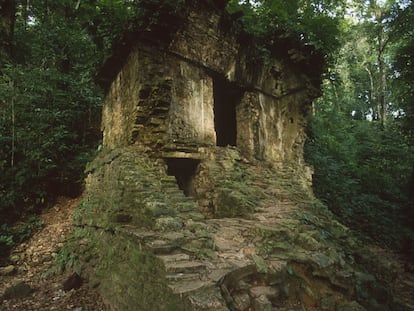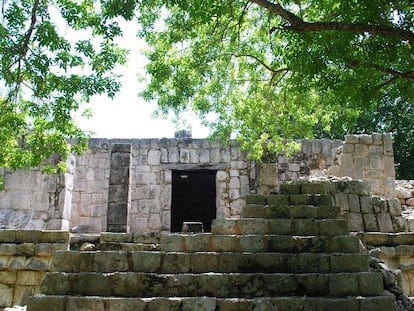The great museum that houses the newly discovered treasures of Chichén Itzá
A 6,500 square foot building protects recent findings from excavations carried out during the construction of the Maya Train route, which have shed light on life in the famous Mexican civilization
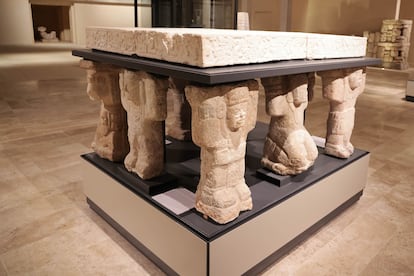

Every day, Francisco Pérez Ruiz travels into the past to one of Mexico’s greatest civilizations. He is in charge of research at the Chichén Itzá archeological zone, and he regularly handles recently uncovered pieces that shed light on what life was like for the Mayans, whose civilization’s rise and decline have long intrigued experts. Pérez Ruiz works in the archeological area of the historic site, where he assesses treasures like vessels, urns, sculptures, incense holders and fragments of the Mayans’ enormous structures, handling it all with the great care and expertise necessary for assembling such artifacts into a complex understanding of the society from which they came. “We try to restore them to their original state, or as close as possible,” says the archaeologist. Once researchers have learned as much as possible from each piece, the items are sent to be exhibited, largely in the Great Museum of Chichén Itzá that officials have built in the archaeological complex, a monumental work that displays the impact that the Mayans have had on the history of Mexico.

The archaeological site was built alongside the soaring structures of Chichén Itza, a major destination that hosts tens of thousands of tourists every year. It’s a complex of square buildings that function as warehouses, where archaeologists work to clean and study each piece that comes out of excavations, the most recent of which began in 2022 and finished in December of last year. The digs are part of a new project to explore archaeological zones near the controversial Mayan Train, President André Manuel López Obrador’s pet infrastructure project. In these warehouses, the pieces of stone and ceramic are cleaned, classified and analyzed. “We do the initial work, which consists in washing and numbering the pieces, each of which are assigned a number according to the place in which they were collected,” says Pérez Ruiz.
The recently discovered treasures are in piles on tables, shelves and even the floors of the warehouses. There are also dozens of boxes with fragments that wait to be reassembled, to tell of how they were used in their era. Very few people have access to the space: these pieces of history are under meticulous care. Among the new findings are sculptures in the shape of snails, skull designs carved into stone, pots, plates, incense holders in the form of warriors or beautiful butterflies. “It is a miscellaneous series that bolsters all the investigation that has been done on the way of life of this region,” says José Osorio, director of Chichén Itzá.
Osorio says that these findings form part of the Program for the Improvement of Archaeological Zones (PROMEZA), run by López Obrador’s administration with the goal of protecting the vast historic regions that will be impacted by the train’s construction, which has raised concerns not only among environmentalists, but also historians and archaeologists who have decried its destruction of lands that could contain a vast amount of cultural heritage. The president has invested more than $119 million in the project, a sum that includes funds to carry out future excavations and build the Great Museum of Chichén Itzá.

Here, archaeologists piece together recovered fragments until they are able to identify their original shape, whether it was a cajete (a pre-Hispanic hollow vessel), molcajete (a stone mortar with three short legs), phallic figure or an urn. “If it can be fully assembled, it goes to restoration, where the piece undergoes very special treatment in which its cracks are filled and it is finished with pigment that gives it back its original appearance. Then the pieces are discharged, their corresponding reports completed, and they are sent to museums to be exhibited,” says Pérez Ruiz. “We identify types and varieties of ceramic, chronology, the period of which the piece was part. Many have indications that they come from the apogee that coincided with the construction of Chichén Itzá,” says the archaeologist.
The pieces that come out of these workshops are proudly displayed in the attention-grabbing new regional museum, a concrete mass that occupies more than 6,500 square feet, dedicated to the preservation of Mexican history. The building is reminiscent of Mayan architecture, with its pyramids and ceremonial structures. It is flanked by an immense parking lot and roadway that welcome visitors with huge, pre-Hispanic stone statues in the form of snakes and reclining Chac Mools. Its design was overseen by the National Coordination of Museums, and masterminded by the architect Juan Garibay. The complex is composed of five large exhibit halls that trace thematic lines through Mayan life, the civilization’s relationship with the environment, its beliefs, its vision of the world, religion, and sacrifices.
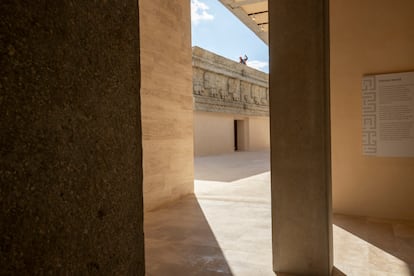
The museum’s ample rooms, illuminated with natural light that enters through tall windows, are overseen by Julio César Alonso. The young archaeologist shares his zeal for protecting these 500-plus pieces with his colleagues from the archaeological zone. The museum’s opening at the beginning of March was presided over by López Obrador, but there are still dozens of laborers working to finish details in its central areas and the large gallery that hosts local artisans, many of whom fan out across the Chichén Itza complex, anxious for tourists to buy their products, many of them knockoffs manufactured in China. The National Guard guards the premises, and throughout the hallways, uniformed officers inspect the museum’s pieces.
On exhibition in glass cases are vessels, funerary urns, figurines of Mayan deities and singular pieces like the so-called atado de años (knot of years), the graphic representation of the 52-year period that the Mayan used to measure time, the equivalent “to the way we see a century”, says Alonso. “It created a ritual to celebrate the beginning of a new era,” says the expert. Among these knots is the planet Venus, which was venerated by the Mayans, who called it the Red Star and considered it the most important celestial body after the sun and the moon. “The importance of these galleries is to give the visitor a way of understanding the Mayan worldview. Chichén Itza was a very important religious and political center, but also a highly significant trade corridor. There were very skilled craftspeople who worked with raw materials to make tools and instruments for everyday use, which were then traded,” says Alonso.
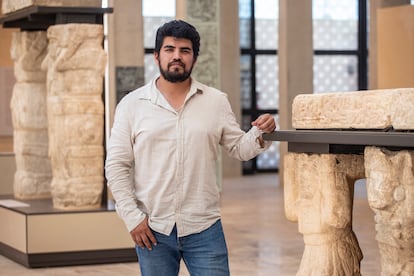
Among the oldest pieces is a set of a pitcher and small cups that dates back to 900 BCE, 2,500 years before our historical era began. There are also enormous stone pieces that show the power of the written word during the time of the Mayans, engraved images that communicate specific messages on behalf of the society’s rulers and distinguished individuals. “I like to refer to it as the propaganda of its time,” says Alonso. “It’s not as special and refined as hieroglyphic writing, but rather, images that people used to communicate general information. Chichén Itzá was a multicultural city, where people from central and northern Mexico and all over Mesoamerica converged. They developed a system for political diffusion, a kind of written language and iconography,” he says. Epigraphists, he says, are now at work deciphering the stones’ messages.
The museum holds in particular regard the Chac Mool, reclining sculptures that represent warriors and that were generally used in Mesoamerica in sacrificial ceremonies. It displays four of the 18 of these figures that have been uncovered in Chichén Itzá. “For a museum to have four Chac Mool is rare,” says Alonso with pride. Some of them are engraved with feathered serpents that represent the movements of the stars, rabbits, which are related to the uterus and to fertility, and Venus, the sacred star that protected warriors. They also feature containers for offerings, some of them formed by turquoise discs.

Chichén Itzá's architectural elements are the focus of one gallery that displays stunning palace reliefs from the archaeological zone. One of them is a fragment found in the southern area of the House of Snails, as is called a group of rooms that were home to Mayan elite and that were recently excavated. The fragment is a magnificent piece, “among Chichén’s most beautiful,” says Alonso. They show a perfectly engraved figure who sits with its arms extended and a penis in the shape of a vine, from which flowers bloom. “We call it the flowery landscape, because life emanates from it. The image also shows certain characteristics of a ruler,” he says. Also on display is a lintel that shows several captives being handed over to a nobleman. They are accompanied by soldiers, known as serpent captains, and a box for offerings. The nobleman holds a flint knife in his hand, ready to make a sacrifice. The lintel is held by atlantes, representations of warriors, some of them portrayed with pectorals in the shape of butterflies. It’s a sample of the level of sophistication that Mayan art had achieved.
But the piece that Alonso holds most dear is an enormous stone onto which a Mayan artist attempted to engrave the head of a serpent. Visitors should take care to note the particular features of the rock, which illustrates the protocol followed by the canteros, or stonecutters, of the era. In it, explains the archaeologist, one can see the cuts that have been chiseled out by the artisan, the outline of the head of the serpent, its nose, eyes and the tracings made by the cantero to form the stone. The piece is approximately 1,500 years old. Why didn’t the stonecutter finish it? “The most probable reason is that while he was working on it, he came across a flaw in the stone, so that when he cut it with the chisel, it caused a large fracture. He must have had to stop working on it at that point, because limestone cannot be glued back together and since this was meant to be the base of a column, it needed to be very solid,” says Alonso.

The treasures form part of a cultural heritage that fills archaeologist María Guadalupe Espinoza, who is the director of the museum and archaeological zone, with pride. She has the weighty task of sharing and preserving this area, which has been cataloged as a UNESCO world heritage site since 1988. The project she leads, she says, has brought development to one of the poorest parts of Mexico, and local workers have been involved in excavations and, overseen by archaeologists, also work on the restoration of new findings. The people who work in the museum are also local, because it’s “ideal that they be the ones to administer these archaeological sites,” she says.
Espinoza is confident that the Mayan Train will attract a wave of visitors to the museum. The nearest station is four kilometers away from the complex and there are already buses that bring tourists between the two, their presence reflected by massive parking spaces in the side lot. She expects at least 500 visitors a day, she says, though that number could rise to 3,000 once the entire complex is complete. The museum, in contrast to the majority of its peers in Mexico, will be open from Monday to Sunday, 8 a.m. to 4 p.m. “This project has brought together a notable research team, in addition to the conservation that is carried out for the pieces and monuments. This museum is extremely important due to the fact that it is the first in Chichén Itzá dedicated to the storage of pieces that belong to the entire world, a cultural heritage that we will take care of so that all can enjoy it. It is one of the best archaeological centers in the world,” says the anthropologist who, alongside her colleagues, will carefully reconstruct and protect the treasures that hold the key to understanding life in the storied Mayan civilization.
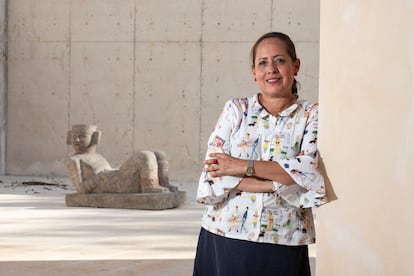
Sign up for our weekly newsletter to get more English-language news coverage from EL PAÍS USA Edition
Tu suscripción se está usando en otro dispositivo
¿Quieres añadir otro usuario a tu suscripción?
Si continúas leyendo en este dispositivo, no se podrá leer en el otro.
FlechaTu suscripción se está usando en otro dispositivo y solo puedes acceder a EL PAÍS desde un dispositivo a la vez.
Si quieres compartir tu cuenta, cambia tu suscripción a la modalidad Premium, así podrás añadir otro usuario. Cada uno accederá con su propia cuenta de email, lo que os permitirá personalizar vuestra experiencia en EL PAÍS.
¿Tienes una suscripción de empresa? Accede aquí para contratar más cuentas.
En el caso de no saber quién está usando tu cuenta, te recomendamos cambiar tu contraseña aquí.
Si decides continuar compartiendo tu cuenta, este mensaje se mostrará en tu dispositivo y en el de la otra persona que está usando tu cuenta de forma indefinida, afectando a tu experiencia de lectura. Puedes consultar aquí los términos y condiciones de la suscripción digital.
More information
Archived In
Últimas noticias
Maduro pleads not guilty before the federal court in New York: ‘I am still the president of Venezuela’
A new test can detect Alzheimer’s from a finger prick
UN team enters Sudanese city of El Fasher after paramilitary massacre: ‘It’s like a ghost town’
A recipe for resistance: Indigenous peoples politicize their struggles from the kitchen
Most viewed
- Gilles Lipovetsky: ‘If you want to live better and fall in love, take Prozac, don’t look to philosophy’
- Alain Aspect, Nobel laureate in physics: ‘Einstein was so smart that he would have had to recognize quantum entanglement’
- Alvin Hellerstein, a 92-year-old judge appointed by Bill Clinton, to preside over Maduro’s trial in New York
- Why oil has been at the center of Venezuela-US conflicts for decades
- Maduro’s downfall puts China’s relationship with Venezuela to the test
